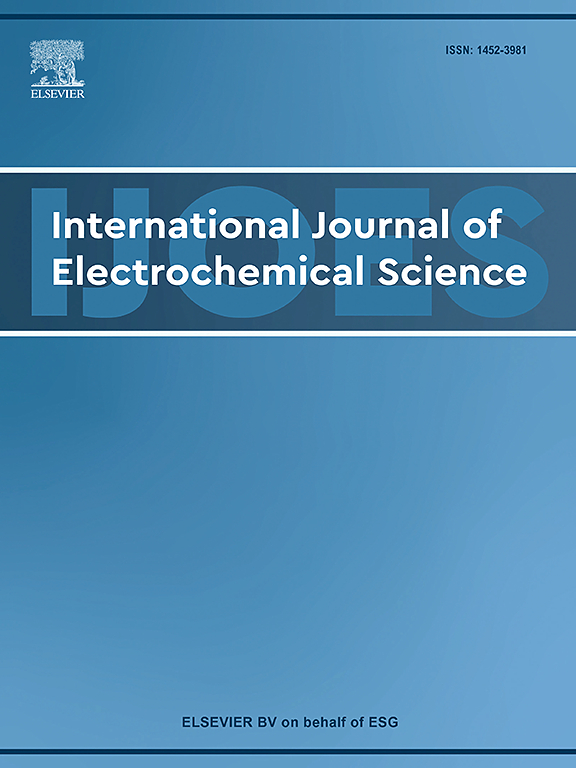Electro-osmotic treatment of dredged sludge using lignosulfonate as additive
IF 2.4
4区 化学
Q4 ELECTROCHEMISTRY
International Journal of Electrochemical Science
Pub Date : 2025-09-16
DOI:10.1016/j.ijoes.2025.101183
引用次数: 0
Abstract
Electro-osmosis (EO) has been widely recognized as a promising technique for the treatment of dredged sludge. However, EO alone often fails to deliver satisfactory results. A more effective approach involves its integration with stabilizing additives. In this study, an eco-friendly polymer stabilizer, lignosulfonate (LS), was incorporated into EO to evaluate their combined effects on the geotechnical behavior of sludge. Two common forms of LS—sodium lignosulfonate (LSS) and calcium lignosulfonate (LSC)—were applied at concentrations of 3 %, 6 %, 12 %, and 20 %. The results showed that the introduction of LS-derived ions (Na⁺ or Ca²⁺) markedly increased soil electrical conductivity, whereas excessive dosages reduced electro-osmotic permeability. LSS-treated soils exhibited higher conductivity than those treated with LSC, owing to the greater mobility of Na⁺ compared with Ca²⁺ under EO. Scanning electron microscopy confirmed that LS promoted soil particle aggregation and improved cohesion. X-ray diffraction indicated little change in the primary mineral composition of sludge, while X-ray fluorescence revealed that LS combined with iron electrodes significantly altered sulfur and iron contents. Overall, the synergistic use of EO and LS improved electrical conduction and enhanced soil microstructure, although its influence on permeability was limited. Mechanistically, soluble salts from LS reduced the zeta potential and electro-osmotic permeability, while the hydrophilic groups of dissolved LS formed a stable adsorption film between soil particles and pore water, further decreasing electro-osmotic permeability.
木质素磺酸盐对疏浚污泥的电渗透处理
电渗透技术是一种很有前途的污泥处理技术。然而,单靠EO往往不能提供令人满意的结果。更有效的方法是将其与稳定添加剂结合使用。在本研究中,将一种环保聚合物稳定剂木素磺酸盐(LS)加入到EO中,以评估它们对污泥岩土性能的综合影响。两种常见形式的木质素磺酸钠(LSS)和木质素磺酸钙(LSC)分别以3 %、6 %、12 %和20 %的浓度施用。结果表明,ls衍生离子(Na +或Ca 2 +)的引入显著提高了土壤的导电性,而过量的引入则降低了土壤的电渗透渗透率。lss处理的土壤比LSC处理的土壤表现出更高的导电性,这是由于在EO下Na +比Ca 2 +的迁移率更高。扫描电镜证实,LS能促进土壤颗粒团聚,提高土壤黏聚力。x射线衍射显示污泥的主要矿物组成变化不大,而x射线荧光显示LS与铁电极结合显著改变了硫和铁的含量。总体而言,EO和LS的协同使用改善了导电性,增强了土壤微观结构,尽管其对渗透率的影响有限。从机理上看,LS的可溶性盐降低了zeta电位和电渗透渗透率,溶解后LS的亲水基团在土壤颗粒和孔隙水之间形成稳定的吸附膜,进一步降低了电渗透渗透率。
本文章由计算机程序翻译,如有差异,请以英文原文为准。
求助全文
约1分钟内获得全文
求助全文
来源期刊
CiteScore
3.00
自引率
20.00%
发文量
714
审稿时长
2.6 months
期刊介绍:
International Journal of Electrochemical Science is a peer-reviewed, open access journal that publishes original research articles, short communications as well as review articles in all areas of electrochemistry: Scope - Theoretical and Computational Electrochemistry - Processes on Electrodes - Electroanalytical Chemistry and Sensor Science - Corrosion - Electrochemical Energy Conversion and Storage - Electrochemical Engineering - Coatings - Electrochemical Synthesis - Bioelectrochemistry - Molecular Electrochemistry

 求助内容:
求助内容: 应助结果提醒方式:
应助结果提醒方式:


